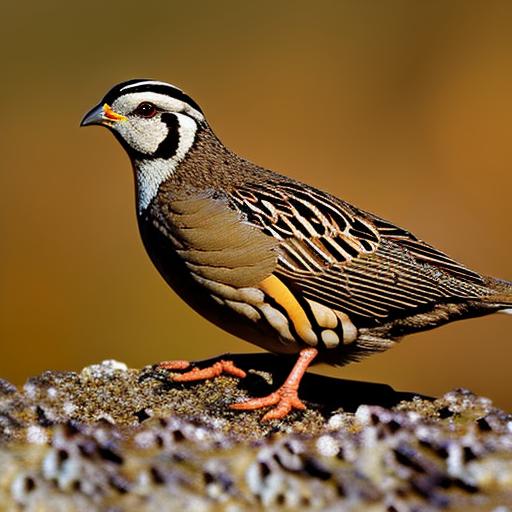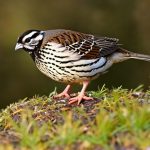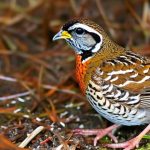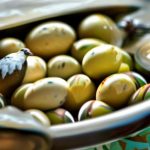The Californian quail, also known as the Valley quail, is a small ground-dwelling bird native to the western United States. They are known for their distinctive teardrop-shaped plume on their head and their vibrant plumage, with a combination of brown, white, and black feathers. These birds are popular among aviculturists and hobbyists due to their charming appearance and pleasant nature. Californian quail are social birds that thrive in small flocks, making them an ideal addition to a backyard aviary or farm setting.
Californian quail are known for their distinctive “chi-ca-go” call, which they use to communicate with each other and establish their territory. They are ground-dwelling birds that prefer to forage for seeds, insects, and vegetation on the forest floor. In captivity, they are relatively easy to care for and can adapt well to a variety of environments. With the right housing, diet, and care, Californian quail can thrive and bring joy to their keepers for many years.
Key Takeaways
- Californian quail are small ground-dwelling birds native to the western United States, known for their distinctive teardrop-shaped plume on their heads.
- When housing Californian quail, it’s important to provide a spacious enclosure with plenty of hiding spots and perches to mimic their natural habitat.
- A balanced diet for Californian quail includes a mix of seeds, grains, greens, and insects, along with access to grit for digestion.
- Regular health checks, parasite control, and a clean living environment are essential for the well-being of Californian quail.
- Breeding Californian quail requires a carefully managed environment with proper nesting areas and a balanced male-to-female ratio to prevent aggression.
Housing and Enclosure for Californian Quail
When it comes to housing Californian quail, it’s important to provide them with a spacious and secure enclosure that mimics their natural habitat. A large aviary or outdoor pen is ideal for these birds, as it allows them to roam and forage freely. The enclosure should be at least 6 feet tall to accommodate their flighty nature and should be covered to protect them from predators and the elements.
The flooring of the enclosure should be covered with a soft substrate such as straw or wood shavings to provide a comfortable surface for the quail to walk on. It’s important to regularly clean and replace the substrate to maintain a clean and hygienic environment for the birds. Additionally, providing hiding spots such as shrubs, bushes, or wooden structures can help the quail feel secure and provide them with places to nest and roost.
In colder climates, it’s essential to provide a heated shelter or insulated area within the enclosure to protect the quail from harsh weather conditions. This can be achieved with the use of heat lamps, heated perches, or heated pads. It’s important to monitor the temperature within the enclosure and make adjustments as needed to ensure the quail are comfortable and healthy.
Diet and Nutrition for Californian Quail
Californian quail are omnivorous birds that require a varied diet to meet their nutritional needs. In the wild, they primarily feed on seeds, grains, insects, and vegetation. In captivity, it’s important to provide them with a balanced diet that includes a high-quality game bird feed as the base of their diet. This can be supplemented with fresh fruits and vegetables such as leafy greens, carrots, and berries to provide additional vitamins and minerals.
It’s important to provide access to grit or small stones in their enclosure, as quail do not have teeth and rely on these materials to help grind down their food in their gizzards. Additionally, offering mealworms or other live insects can provide essential protein and enrichment for the quail.
Fresh, clean water should always be available for the quail, either through a gravity-fed waterer or shallow dishes that are easy for them to access. It’s important to regularly clean and refill the water containers to prevent contamination and ensure the quail stay hydrated.
Health and Care for Californian Quail
Maintaining the health and well-being of Californian quail is essential for their longevity and happiness in captivity. Regular observation of the birds is important to monitor their behavior, appetite, and overall condition. Any signs of illness or injury should be addressed promptly by a qualified avian veterinarian.
It’s important to provide regular dust baths for the quail, as this helps them maintain healthy plumage and skin by removing excess oils and parasites. This can be achieved by providing a shallow container filled with fine sand or dust that the quail can use for bathing.
Regular cleaning of the enclosure is essential to prevent the buildup of waste and bacteria that can lead to health issues for the quail. This includes removing soiled substrate, cleaning food and water containers, and disinfecting the enclosure on a regular basis.
Additionally, providing opportunities for exercise and mental stimulation is important for the overall well-being of the quail. This can be achieved by providing perches, branches, and other structures for them to climb on, as well as offering toys or puzzles that encourage natural behaviors such as foraging.
Breeding and Reproduction of Californian Quail
Breeding Californian quail can be a rewarding experience for aviculturists and hobbyists alike. These birds are relatively prolific breeders and can produce multiple clutches of eggs throughout the breeding season. To encourage breeding behavior, it’s important to provide a suitable nesting area within the enclosure, such as a shallow depression lined with soft nesting material.
During the breeding season, male quail will display courtship behavior such as puffing up their plumage, vocalizing, and performing elaborate mating displays to attract females. Once a pair has bonded, the female will lay a clutch of eggs in the nest, typically ranging from 12-16 eggs. It’s important to provide a quiet and secure environment for the nesting pair to minimize stress and disturbances during this time.
Incubating the eggs can be done using an artificial incubator or by allowing the female to incubate them herself. If using an incubator, it’s important to maintain stable temperature and humidity levels throughout the incubation period. The eggs will typically hatch after 21-23 days, at which point the chicks will require warmth, protection, and access to a high-protein starter feed.
Behavioral Enrichment and Socialization for Californian Quail
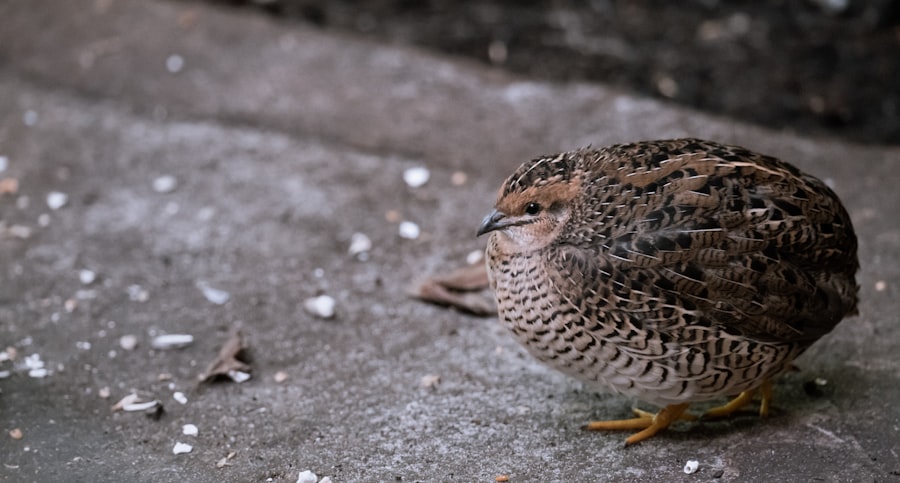
Californian quail are social birds that thrive in small flocks, making socialization an important aspect of their care in captivity. Providing them with companionship is essential for their mental well-being, so it’s recommended to keep them in groups of at least 4-6 birds. This allows them to engage in natural behaviors such as foraging together, grooming each other, and establishing social hierarchies within the flock.
In addition to socialization, providing behavioral enrichment is important for keeping quail mentally stimulated and preventing boredom. This can be achieved by providing natural materials such as branches, logs, or rocks for them to explore and interact with. Additionally, offering toys or puzzles that encourage natural behaviors such as pecking or scratching can provide mental stimulation for the quail.
It’s also important to provide opportunities for exercise within the enclosure by including perches or platforms at varying heights for the quail to climb on. This not only encourages physical activity but also allows them to exhibit natural behaviors such as roosting and surveying their surroundings.
Legal Considerations for Keeping Californian Quail
Before acquiring Californian quail, it’s important to research and understand any legal considerations or regulations regarding their ownership in your area. In some regions, a permit or license may be required to keep these birds in captivity, especially if you plan on breeding or selling them.
Additionally, it’s important to consider any zoning restrictions or homeowner’s association rules that may impact your ability to keep quail on your property. Some areas have specific regulations regarding the size and type of enclosures allowed for keeping birds, so it’s important to familiarize yourself with these guidelines before establishing an aviary.
It’s also important to consider the ethical implications of keeping quail in captivity and ensure that you are able to provide them with a suitable environment that meets their physical and behavioral needs. This includes providing adequate space, shelter, socialization, and enrichment opportunities to ensure the well-being of the birds.
In conclusion, keeping Californian quail can be a rewarding experience for aviculturists and hobbyists who are able to provide them with proper housing, diet, care, socialization, and enrichment opportunities. By understanding their natural behaviors and needs, keepers can create a thriving environment for these charming birds while also ensuring they comply with any legal considerations related to their ownership.
If you’re interested in keeping Californian quail, you might also want to consider the importance of providing a suitable coop and nest box for them. A well-designed coop and nest box can contribute to the health and productivity of your quail. For more information on creating the ideal coop and nest box for your quail, check out this helpful article on PoultryWizard.
FAQs
What is the natural habitat of Californian quail?
Californian quail are native to western North America and can be found in a variety of habitats including grasslands, deserts, and foothills.
What do Californian quail eat?
Californian quail primarily feed on seeds, fruits, and insects. They also consume a variety of plants and small invertebrates.
How do you keep Californian quail in captivity?
When keeping Californian quail in captivity, it is important to provide a spacious and secure enclosure with plenty of hiding spots and vegetation. They should also have access to a balanced diet and fresh water.
What are the key considerations for keeping Californian quail?
Key considerations for keeping Californian quail include providing a suitable habitat, ensuring proper nutrition, and minimizing stress. It is also important to consider their social behavior and provide appropriate companionship.
Are there any legal considerations for keeping Californian quail?
Before keeping Californian quail, it is important to check local regulations and obtain any necessary permits or licenses. In some areas, keeping quail may be subject to specific regulations to protect native wildlife.
Meet Walter, the feathered-friend fanatic of Florida! Nestled in the sunshine state, Walter struts through life with his feathered companions, clucking his way to happiness. With a coop that’s fancier than a five-star hotel, he’s the Don Juan of the chicken world. When he’s not teaching his hens to do the cha-cha, you’ll find him in a heated debate with his prized rooster, Sir Clucks-a-Lot. Walter’s poultry passion is no yolk; he’s the sunny-side-up guy you never knew you needed in your flock of friends!

